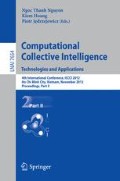Abstract
This work focuses on investigating the importance of evaluating the likelihood that a particular collaboration option is going to be profitable for a firm. Some collaboration options for a firm are first evaluated by experts on previously agreed upon criteria. Methods from rough set theory are afterwords employed for ordering of the agreed upon criteria with respect to their significance in predicting collaboration outcomes.
Access this chapter
Tax calculation will be finalised at checkout
Purchases are for personal use only
Preview
Unable to display preview. Download preview PDF.
References
Belnap, N.J.: How a computer should think. In: Contemporary Aspects of Philosophy. Proceedings of the Oxford International Symposia, Oxford, GB, pp. 30–56 (1975)
Davey, B.A., Priestley, H.A.: Introduction to lattices and order. Cambridge University Press, Cambridge (2005)
Duntsch, I., Gediga, G.: Rough set data analysis: A road to non-invasive knowledge discovery. Methods Publishers (2000) ISBN: 190328001X
Fitting, M.: Kleene’s Logic, Generalized. Journal of Logic and Computation 1(6), 797–810 (1991)
Font, J.M., Moussavi, M.: Note on a six valued extension of three valued logics. Journal of Applied Non-Classical Logics 3, 173–187 (1993)
Garcia, O.N., Moussavi, M.: A Six-Valued Logic for Representing Incomplete Knowledge. In: Proceedings of the 20th International Symposium on Multiple-Valued Logic (ISMVL), pp. 110–114. IEEE Computer Society Press, Charlotte (1990)
García-Duque, J., López-Nores, M., Pazos-Arias, J., Fernández-Vilas, A., Díaz-Redondo, R., Gil-Solla, A., Blanco-Fernández, Y., Ramos-Cabrer, M.: A Six-valued Logic to Reason about Uncertainty and Inconsistency in Requirements Specifications. Journal of Logic and Computation 16(2), 227–255 (2006)
Kaluzhny, Y., Muravitsky, A.Y.: A knowledge representation based on the Belnap’s four valued logic. Journal of Applied Non-Classical Logics 3, 189–203 (1993)
Kleene, S.: Introduction to Metamathematics. D. Van Nostrand Co., Inc., New York (1952)
Lukasiewicz, J.: On Three-Valued Logic. Ruch Filozoficzny 5 (1920), English translation in Borkowski, L. (ed.): Lukasiewicz, J.: 1970, Selected Works. North Holland, Amsterdam (1920)
Moussavi, M., Garcia, O.N.: A Six-Valued Logic and Its Application to Artificial Intelligence. In: Proceedings of the Fifth Southeastern Logic Symposium (1989)
Pawlak, Z.: Rough Sets. International Journal of Computer and Information Sciences 11, 341–356 (1982)
Pawlak, Z.: Rough Sets: Theoretical Aspects of Reasoning about Data, vol. 9. Kluwer Academic Publishers, Dordrecht (1991)
Bierman, H., Smidt, S.: The Capital Budgeting Decision. Routledge, New York (2007)
Klein, G.A.: Recognition-Primed Decision Making. In: Klein, G.A. (ed.) Sources of Power: How People Make Decisions, pp. 15–30. MIT Press, Cambridge (1998)
Layard, R., Glaister, S.: Cost-Benefit Analysis, 2nd edn. Cambridge University Press (1994)
Nas, T.F.: Cost-benefit Analysis, Theory and Application. Sage Publications (1996)
Sim, K.M.: Bilattices and Reasoning in Artificial Intelligence: Concepts and Foundations. Artificial Intelligence Review 15(3), 219–240 (2001)
Zirger, B.J., Maidique, M.: A model of new product development: an empirical test. Management Science 36, 867–883 (1990)
Wagner, G.: Vivid Logic. LNCS (LNAI), vol. 764. Springer, Heidelberg (1994)
Author information
Authors and Affiliations
Editor information
Editors and Affiliations
Rights and permissions
Copyright information
© 2012 Springer-Verlag Berlin Heidelberg
About this paper
Cite this paper
Encheva, S. (2012). Ordering of Potential Collaboration Options. In: Nguyen, NT., Hoang, K., Jȩdrzejowicz, P. (eds) Computational Collective Intelligence. Technologies and Applications. ICCCI 2012. Lecture Notes in Computer Science(), vol 7654. Springer, Berlin, Heidelberg. https://doi.org/10.1007/978-3-642-34707-8_17
Download citation
DOI: https://doi.org/10.1007/978-3-642-34707-8_17
Publisher Name: Springer, Berlin, Heidelberg
Print ISBN: 978-3-642-34706-1
Online ISBN: 978-3-642-34707-8
eBook Packages: Computer ScienceComputer Science (R0)

